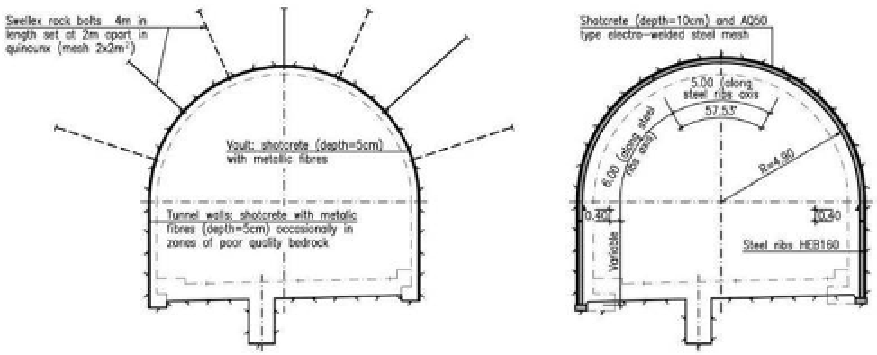Environmental Engineering Reference
In-Depth Information
breccia (Brc), very resistant and homogeneous for-
mations, corresponding to a zone of good quality
bedrock. Geotechnical zone ZG2 had a more het-
erogeneous structure, comprised of resistant rocks,
faulted basalts (βF), occasionally intercalated with
materials of poorer characteristics but of a shallow
depth, behaving as a whole as a reasonable quality
formation. in geotechnical zone ZG3 friable and
weak cohesive formations predominate such as
rocks of weak resistance and compacted or loosely
consolidated soils, in other words, disaggregated
breccia (DBr), compact tuff (cT) and compact
tuffs with volcanic bombs (TVB), comprising for-
mations of poorer quality. Geotechnical zone ZG4
encompasses all the formations of geotechnical
zone ZG3 but associated with stretches of shallow
covering and an important presence of water.
To calculate primary lining, empirical methods
adjusted to the volcanic formations crossed were
used, such as the geomechanical classifications of
rocky bedrock for tunnels by Bieniawski, Manuel
Rocha, Terzaghi and aFTes recommendations
(Brito et al. 2002).
Based on the geological-geotechnical charac-
terisation obtained and taking into account the
primary lithological types present in each of the
geotechnical zones determined, three distinct con-
struction phases were defined for the current sec-
tion, each one corresponding to a specific type of
primary and secondary lining.
The main difference between the construction
phases adopted resulted from the specified rate of
excavation and subsequent application of primary
lining.
hence, in geotechnical zone ZG1 excavation was
made in full cross-section at a maximum construc-
tion of 6 m and application of primary lining com-
prised of 4.0 m swellex rock bolts associated with
5 cm of shotcrete applied only on faulted bedrock
zones and/or those more substantially altered.
in tunnel stretches crossing formations belong-
ing to geotechnical zones ZG2 and ZG3, excava-
tion was carried out in phases, upper and lower
mid-sections, progressing a maximum of 2 m and
1 m at a time respectively, ensuring a minimum dif-
ference between phases of 20 m.
The primary lining applied also differed, lighter
for geotechnical zone ZG2, which consisted of
applying 4.0 m swellex rock bolts at 2 m intervals in
the vault and 5 to 10 cm of shotcrete with metallic
fibres, whilst application of shotcrete with metallic
fibres was limited to 5 cm at walls in the zones of
poorer quality bedrock. in geotechnical zone ZG3
heavier primary lining was applied comprising
heB160 steel ribs at 1 m intervals, aQ50 electro-
welded steel mesh and 10cm of systematic shotcrete
ZG4 differed from ZG3 merely with regard to the
spacing adopted for steel ribs which was 0.70 m.
construction of the 3 parking lay-bys of the
tunnel was adjusted during the construction phase
itself using borings at the face in order to locate
zones of bedrock with the best characteristics.
excavation was recommended in phases, begin-
ning with the excavation of a central gallery located
at the keystone of the vault in order to enable a
detailed geological study of the bedrock during
advance of the face, then proceeding with the dis-
mantling of the lateral areas. after the upper mid-
section had been excavated, excavation continued
on the lower part, beginning with the dismantling
of the central section followed by the lateral areas.
Primary lining recommended for lay-bys consisted
of the systematic application of 6 m super swellex
rock bolts in a 1.5 m × 1.5 m mesh, aQ50 welded
steel mesh and 15 cm of shotcrete.
Figure 8.
Primary linings defined for geotechnical zones ZG2 and ZG3.















